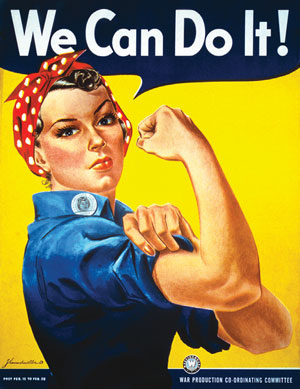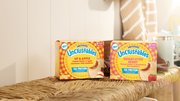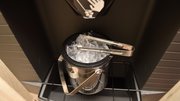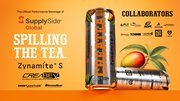Blog
Know The Coffee Breaks History To Emphasize Benefits To Clients
February 2, 2015 | Len Rashkin
TAGS: Vending Times columnist, OCS salespeople, office coffee service, office coffee sales, OCS education, OCS customer service, coffee business, office refreshments, OCS sales training, Len Rashkin, history of coffee break, factory culture, Rosie the Riveter, We Can Do It!, Ray Ade, Cory Coffee |
So, when did the "coffee break" begin? This is for all of you under 50, who may not know how your industry first began. For the coffee service veterans, this may be a bit nostalgic. I will then resume discussing the main ingredient that binds our industry together: coffee.
 The modern coffee break began during World War II, when many of our men went overseas to fight in the war. In the Arsenal of Democracy, war production required the expansion of many factories and the construction of quite a few new ones, especially to manufacture aircraft. Thousands of women joined the workforce to build airplanes and munitions. A popular poster of the time was "We Can Do It," depicting a woman -- Rosie the Riveter -- flexing her muscles.
The modern coffee break began during World War II, when many of our men went overseas to fight in the war. In the Arsenal of Democracy, war production required the expansion of many factories and the construction of quite a few new ones, especially to manufacture aircraft. Thousands of women joined the workforce to build airplanes and munitions. A popular poster of the time was "We Can Do It," depicting a woman -- Rosie the Riveter -- flexing her muscles.
That expanded workforce needed to stay alert and refreshed for those long hours on the assembly lines. Factories ran 24/7, and a 15-minute coffee break was introduced every four hours.
After we won the war, unions gained strength, and one of their demands was to have these CBs put into their contracts with employers. And, of course, the office workers saw the benefit of this to the production people, and they wanted coffee breaks, too. So, there you have it!
In 1964, Cory Corp. of Chicago, a manufacturer of coffee equipment for the restaurant trade, had just lost a major foodservice contract and had removed hundreds of C-25 automatic brewers from that lost client. The equipment was replaced by a new automatic brewer manufactured by Bunn-O-Matic Corp., the five-burner RT.
A gentleman named Ray Ade Sr., who was working for Cory Corp., was asked to try and place all of those brewers without a home. He conceived, and was allowed to implement, a plan for putting them into offices with the offer of selling freshly brewed coffee for a nickel a cup. The nickel cost was derived by using a 2.5-oz. package of coffee to make 64 fluid ounces of brew, and serving the equivalent of a 6-fl.oz. restaurant cup. The cup was filled with approximately 5 fluid ounces leaving room for milk and sugar.
In 1965, Ray Ade, along with his son Ray Ade Jr. took this concept on the road to solicit offices in the greater Chicagoland area, and they found a market that was looking for something new and delicious to give their employees. The first account that they sold was called "Scriptures," a printer of religious books ("An angel was looking over us," they said).
As a result of that success, Cory opened additional divisions across the country. Cory sold its OCS business to Hershey later on, and then Hershey sold it to ARA Services (now Aramark) in the late 1990s.
This information was provided to me many years ago by Ray Ade Jr., who is an OCS operator. I also had the pleasure of playing tennis with Ray Ade Sr. in Dallas in the '80s, during a National Coffee Service Association Convention weekend. He was a fabulous gentleman and the father of our great industry.
Now back to coffee and how it relates to the office environment. I think we all agree that "The Coffee Break was designed to keep employees in the office." If an employer is spending money for staff's coffee breaks, but they are still leaving the office because they want a better cup, then the purpose of offering free coffee in the office has been defeated.
Knowing the purpose of providing good coffee in the office, a salesperson should never have to apologize to an account, to offer a better coffee for more money. A simple statement by you or your sales team is: "Mr. Customer, for an extra few pennies per cup, you can take back control of your coffee break and keep people in the office with great tasting coffee," and/or "Keep in mind that the most expensive cup of coffee is the one that is wasted."
Lastly, high-quality coffee has a major impact in the office environment and in the restaurant industry. Its benefits include:
» Image. A great-tasting brew leaves a positive image with the account's staff, as well as its clients and guests. If you are servicing the restaurant trade, the first impression when entering an eatery is important -- but the last impression is more important: it will create repeat customers. Make your coffee beverage the one they will remember.
» Environment. The office environment will be better to work in when employees are given coffee that they like. There will be fewer complaints from the staff, and this will create better working conditions.
» Morale. Happy employees work better, and quality coffee in the office eliminates employees having to spend their own money at cafés and other establishments across the street and down the block.
» Productivity. With high morale, a better workplace and company with a quality image, all employees will be more productive. They will spend more time at their desks, be available for more phone calls and provide better service to customers. All those benefits contribute to a more profitable company.
These points must be ingrained in your salespeople. If you or your salespeople do not believe in the benefits of quality coffee, then you and they cannot project the passionate assurance that what you will be offering to your customers will be a valuable benefit.
I wish all of you a very healthy, happy and successful New Year. Please let me know what subjects you would like me to write about in the future. I can be reached at (516) 241-4883, or by email at OCSconsultant@aol.com.
LEN RASHKIN is a pioneer in office coffee service. He founded Coffee Sip in 1968 and later merged it with Dell Coffee, of which he became president in 1991. Sales at Dell topped $7 million. He also founded the Eastern Coffee Service Association and National Beverage & Products Association. He is a speaker at national and local trade conferences, consults on OCS sales and marketing, and is the author of two OCS training programs.







